What is the process for measuring low current using an ammeter and a multimeter?
I. Measuring small currents using an ammeter
Select an appropriate ammeter
Choose an ammeter range according to the estimated current magnitude. If the current magnitude is uncertain, first select a larger range for a trial measurement to avoid damage to the ammeter due to the current exceeding the range. For example, if the estimated current is at the milliampere level, select a milliampere meter.
At the same time, pay attention to the type of ammeter. There are DC ammeters and AC ammeters. For DC current, use a DC ammeter; for AC current, use an AC ammeter.
Connect the ammeter
Connect in series: Connect the ammeter in series to the measured circuit. This is because the current is equal everywhere in a series circuit. Only by connecting in series can the current in the circuit be accurately measured.
For example, in a simple DC circuit, disconnect the branch where the current is to be measured, and connect the positive and negative terminals of the ammeter to the two ends of the disconnection respectively. Ensure that the current flows into the positive terminal of the ammeter and out from the negative terminal. For AC ammeters, generally there is no distinction between positive and negative poles, but also pay attention to the stability of the connection.
Perform measurement
After connecting the ammeter, close the circuit switch. At this time, the pointer of the ammeter will deflect. Read the scale value indicated by the pointer of the ammeter. This value is the current magnitude in the measured circuit.
When reading data, pay attention to the scale division value of the ammeter dial. For example, the division value of a milliampere meter may be 0.1mA. Read the data accurately according to the pointer position.
Operations after measurement
After the measurement is completed, first turn off the circuit switch, and then remove the ammeter from the circuit. Store the ammeter properly to avoid impacts or placing it in harsh environments such as humidity and high temperature.
II. Measuring small currents using a multimeter
Select the multimeter range and function position
Set the multimeter to the current measurement position. Like the ammeter, choose an appropriate range according to the estimated current magnitude. If the current magnitude is uncertain, first select a larger range for a trial measurement.
At the same time, pay attention to whether the current is DC or AC. For DC current, set the multimeter to the DC current position; for AC current, set the multimeter to the AC current position. For example, when measuring the current in a battery-powered circuit, use the DC current position.
Connect the multimeter
Also connect the multimeter in series to the measured circuit. Find the current measurement jack of the multimeter. For different ranges, there may be different jacks. Generally, insert the red test lead into the current measurement jack and the black test lead into the common (COM) jack.
For example, when measuring the DC current of a low-power electronic device, first disconnect the circuit, insert the red test lead into the corresponding DC current measurement jack, insert the black test lead into the COM jack, and then connect the red and black test leads in series to the disconnected circuit.
Measure and read data
After connecting, turn on the power supply of the measured circuit. The number displayed on the multimeter is the measured current magnitude.
When reading data, pay attention to the unit and precision displayed on the multimeter. Some multimeters can automatically switch units, such as switching between milliamperes and microamperes. Record the data accurately according to the actual situation.
Operations after measurement
After the measurement is completed, first turn off the power supply of the measured circuit, and then remove the multimeter from the circuit. Adjust the function position of the multimeter to the voltage measurement position or other non-current positions to prevent damage to the multimeter due to misoperation next time. At the same time, place the test leads properly to avoid damage to the test leads.
The Electricity Encyclopedia is dedicated to accelerating the dissemination and application of electricity knowledge and adding impetus to the development and innovation of the electricity industry.




